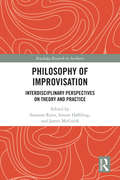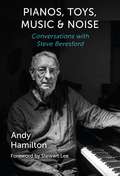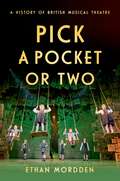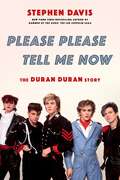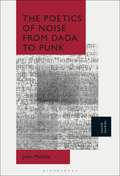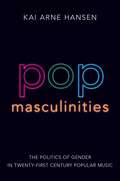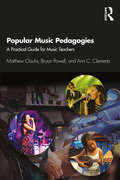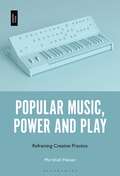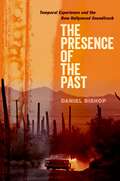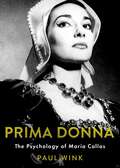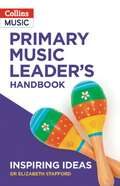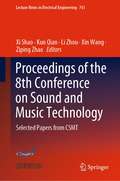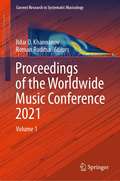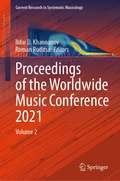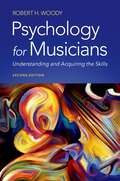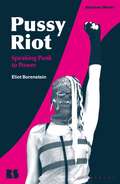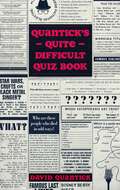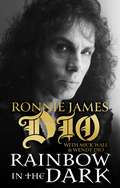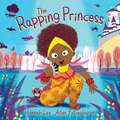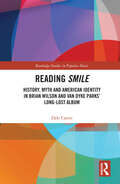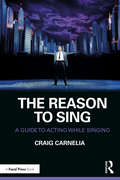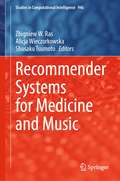- Table View
- List View
Philosophy of Improvisation: Interdisciplinary Perspectives on Theory and Practice (Routledge Research in Aesthetics)
by Susanne Ravn; Simon Høffding; James McGuirkThis volume brings together philosophical and interdisciplinary perspectives on improvisation. The contributions connect the theoretical dimensions of improvisation with different viewpoints on its practice in the arts and the classroom. The chapters address the phenomenon of improvisation in two related ways. On the one hand, they attend to the lived practices of improvisation both within and without the arts in order to explain the phenomenon. They also extend the scope of improvisational practices to include the role of improvisation in habit and in planned action, at both individual and collective levels. Drawing on recent work done in the philosophy of mind, they address questions such as whether improvisation is a single unified phenomenon or whether it entails different senses that can be discerned theoretically and practically. Finally, they ask after the special kind of improvisational expertise which characterizes musicians, dancers, and other practitioners, an expertise marked by the artist’s ability to participate competently in complex situations while deliberately relinquishing control. Philosophy of Improvisation will appeal to anyone with a strong interest in improvisation, to researchers working in philosophy, aesthetics, and pedagogy as well as practitioners involved in different kinds of music, dance, and theater performances.
Pianos, Toys, Music and Noise: Conversations with Steve Beresford
by Andy HamiltonSteve Beresford's polymathic activities have formed a prism for the UK improv scene since the 1970s. He is internationally known as a free improviser on piano, toy piano and electronics, composer for film and TV, and raconteur and Dadaist visionary. His résumé is filled with collaborations with hundreds of musicians and other artists, including such leading improvisers as Derek Bailey, Evan Parker and John Zorn, and he has given performances of works by John Cage and Christian Marclay. In this book, Beresford is heard in his own words through first-hand interviews with the author. Beresford provides compelling insight into an extensive range of topics, displaying the broad cultural context in which music is embedded. The volume combines chronological and thematic chapters, with topics covering improvisation and composition in jazz and free music; the connections between art, entertainment and popular culture; the audience for free improvisation; writing music for films; recording improvised music in the studio; and teaching improvisation. It places Beresford in the context of improvised and related musics – jazz, free jazz, free improvisation – in which there is growing interest.
Pick a Pocket Or Two: A History of British Musical Theatre
by Ethan MorddenFrom Gilbert and Sullivan to Andrew Lloyd Webber, from Julie Andrews to Hugh Jackman, from Half a Sixpence to Matilda, Pick a Pocket Or Two is the story of the British musical: where it began and how it developed. In Pick a Pocket Or Two, acclaimed author Ethan Mordden brings his wit and wisdom to bear in telling the full history of the British musical, from The Beggar's Opera (1728) to the present, with an interest in isolating the unique qualities of the form and its influence on the American model. To place a very broad generalization, the American musical is regarded as largely about ambition fulfilled, whereas the British musical is about social order. Oklahoma!'s Curly wins the heart of the farmer Laurey--or, in other words, the cowboy becomes a landowner, establishing a truce between the freelancers on horseback and the ruling class. Half a Sixpence, on the other hand, finds a working-class boy coming into a fortune and losing it to fancy Dans, whereupon he is reunited with his working-class sweetheart, his modest place in the social order affirmed. Anecdotal and evincing a strong point of view, the book covers not only the shows and their authors but the personalities as well--W. S. Gilbert trying out his stagings on a toy theatre, Ivor Novello going to jail for abusing wartime gas rationing during World War II, fabled producer C. B. Cochran coming to a most shocking demise for a man whose very name meant "classy, carefree entertainment." Unabashedly opinionated and an excellent stylist, author Ethan Mordden provokes as much as he pleases. Mordden is the preeminent historian of the form, and his book will be required reading for readers of all walks, from the most casual of musical theater goers to musical theater buffs to students and scholars of the form.
Please Please Tell Me Now: The Duran Duran Story
by Stephen DavisLifelong fans and interested newcomers will love this stunning biography of Duran Duran by the best-selling author of Gold Dust Woman and Hammer of the Gods. In Please Please Tell Me Now, best-selling rock biographer Stephen Davis tells the story of Duran Duran, the quintessential band of the 1980s. Their pretty boy looks made them the stars of fledgling MTV, but it was their brilliant musicianship that led to a string of number one hits. By the end of the decade, they had sold 60 million albums; today, they've sold over 100 million albums - and counting. Davis traces their roots to the austere 1970s British malaise that spawned both the Sex Pistols and Duran Duran - two seemingly opposite music extremes. Handsome, British, and young, it was Duran Duran that headlined Live Aid, not Bob Dylan or Led Zeppelin. The band moved in the most glamorous circles: Nick Rhodes became close with Andy Warhol, Simon LeBon with Princess Diana, and John Taylor dated quintessential British bad girl Amanda De Cadanet. With timeless hits like "Hungry Like the Wolf", "Girls on Film", "Rio", "Save a Prayer", and the best-selling James Bond theme in the series' history, "A View to Kill", Duran Duran has cemented its legacy in the pop pantheon - and with a new album and a worldwide tour on the way, they show no signs of slowing down anytime soon. Featuring exclusive interviews with the band, Please Please Tell Me Now offers a definitive account of one of the last untold sagas in rock and roll history - a treat for diehard fans, new admirers, and music lovers of any age.
The Poetics of Noise from Dada to Punk
by John MelilloBy reinterpreting 20th-century poetry as a listening to and writing through noise, The Poetics of Noise from Dada to Punk constructs a literary history of noise through poetic sound and performance. This book traces how poets figure noise in the disfiguration of poetic voice. Materializing in the threshold between the heard and the unheard, noise emerges in the differentiation and otherness of sound. It arises in the folding of an “outside” into the “inside” of poetic performance both on and off the page. Through a series of case studies ranging from verse by ear-witnesses to the First World War, Dadaist provocations, jazz modernist song and poetry, early New York City punk rock, contemporary sound poetry, and noise music, The Poetics of Noise from Dada to Punk describes productive failures of communication that theorize listening against the grain of sound's sense.
Pop Masculinities: The Politics of Gender in Twenty-First Century Popular Music
by Kai Arne HansenIn Pop Masculinities, author Kai Arne Hansen investigates the performance and policing of masculinity in pop music as a starting point for grasping the broad complexity of gender and its politics in the early twenty-first century. Drawing together perspectives from critical musicology, gender studies, and adjacent scholarly fields, the book presents extended case studies of five well-known artists: Zayn, Lil Nas X, Justin Bieber, The Weeknd, and Take That. By directing particular attention to the ambiguities and contradictions that arise from these artists' representations of masculinity, Hansen argues that pop performances tend to operate in ways that simultaneously reinforce and challenge gender norms and social inequalities. Providing a rich exploration of these murky waters, Hansen merges the interpretation of recorded song and music video with discourse analysis and media ethnography in order to engage with the full range of pop artists' public identities as they emerge at the intersections between processes of performance, promotion, and reception. In so doing, he advances our understanding of the aesthetic and discursive underpinnings of gender politics in twenty-first century pop culture and encourages readers to contemplate the sociopolitical implications of their own musical engagements as audiences, critics, musicians, and scholars.
Popular Music Pedagogies: A Practical Guide for Music Teachers
by Matthew Clauhs Bryan Powell Ann C. ClementsPopular Music Pedagogies: A Practical Guide for Music Teachers provides readers with a solid foundation of playing and teaching a variety of instruments and technologies, and then examines how these elements work together in a comprehensive school music program. With individual chapters designed to stand independently, instructors can adapt this guide to a range of learning abilities and teaching situations by combining the pedagogies and methodologies presented. This textbook is an ideal resource for preservice music educators enrolled in popular music education, modern band, or secondary general methods coursework and K-12 music teachers who wish to create or expand popular music programs in their schools. The website includes play-alongs, video demonstrations, printed materials, and links to useful popular music pedagogy resources.
Popular Music Pedagogies: A Practical Guide for Music Teachers
by Matthew Clauhs Bryan Powell Ann C. ClementsPopular Music Pedagogies: A Practical Guide for Music Teachers provides readers with a solid foundation of playing and teaching a variety of instruments and technologies, and then examines how these elements work together in a comprehensive school music program. With individual chapters designed to stand independently, instructors can adapt this guide to a range of learning abilities and teaching situations by combining the pedagogies and methodologies presented. This textbook is an ideal resource for preservice music educators enrolled in popular music education, modern band, or secondary general methods coursework and K-12 music teachers who wish to create or expand popular music programs in their schools. The website includes play-alongs, video demonstrations, printed materials, and links to useful popular music pedagogy resources.
Popular Music, Power and Play: Reframing Creative Practice
by Marshall HeiserOnce the domain of a privileged few, the art of record production is today within the reach of all. The rise of the ubiquitous DIY project studio and internet streaming have made it so. And while the creative possibilities available to everyday musicians are seemingly endless, so too are the multiskilling and project management challenges to be faced. In order to demystify the contemporary popular-music-making phenomenon, Marshall Heiser reassesses its myriad processes and wider sociocultural context through the lens of creativity studies, play theory and cultural psychology. This innovative new framework is grounded in a diverse array of creative-practice examples spanning the CBGBs music scene to the influence of technology upon modern-day music. First-hand interviews with Jerry Harrison (Talking Heads), Bill Bruford (King Crimson, Yes) and others whose work has influenced the way records are made today are also included. Popular Music, Power and Play is as thought provoking as it will be indispensable for scholars, practitioners and aficionados of popular music and the arts in general.
The Presence of the Past: Temporal Experience and the New Hollywood Soundtrack (Oxford Music / Media)
by Daniel BishopThe Presence of the Past offers a new perspective on Hollywood's "New Wave" as engaged with the vitality of sensory experience and the affective imagination. As author Daniel Bishop shows, the soundtracks of several key films of the New Hollywood Cinema of the late 1960s and 70s cultivated an array of sensibilities regarding the American past. This importance of the past exceeded the New Hollywood's acknowledged use of genre revisionism as a vehicle for timely ideological commentary. There was also a vital tendency in this era to locate the past as an object of imagined phenomenal presence. Although this concept of the past never solidified into a self-conscious discourse, it was nevertheless woven into film culture, readable between the lines of criticism, cultural reception, New Wave aesthetics, and in the aesthetic and industrial transformations of sound design and film music. Bonnie and Clyde (1967), Butch Cassidy and the Sundance Kid (1969), McCabe and Mrs. Miller (1971), The Last Picture Show (1971), American Graffiti (1973), Chinatown (1974), and Badlands (1973) are not only key texts of an exciting era in American popular cinema. They are also mediations upon the presence of the past, an image central to the polarities of visceral energy and ambiguous ephemerality, of utopian dreams and melancholy resignation that characterized this cinema. These sensibilities of pastness engage in diverse ways with myth, nostalgia, paranoia, and existential alienation. They are, however, also united by a concern both with the experiential actuality of the past and with the distances that inevitably separate us from this actuality.
Prima Donna: The Psychology of Maria Callas (Inner Lives)
by Paul WinkPrima Donna: The Psychology of Maria Callas explores the psychological mechanisms underlying the hypnotic power of Callas's artistry and the unfolding of her tragic life story. Although precipitated by the trauma and shame that followed her abandonment by Aristotle Onassis and the rapid deterioration of her voice, Callas's midlife disintegration reflects deep psychological vulnerabilities. In this book, Wink utilizes cutting-edge advances in research on developmental psychology and narcissism to shed light on Callas's puzzling personal deterioration during the last nine years of her life. Lacking a cohesive and integrated sense of self, Callas sought affirmation and vitality from adoring audiences and older men including her husband Battista Meneghini and her long-term partner Onassis. The propensity to fuse her identity with stage roles contributed to her artistic greatness, but envy and the lack of an intrinsic sense of meaning and worth intensified her vulnerability to life's vicissitudes. Prima Donna is both a powerful study of Callas's life and a contribution to the greater body of work on the psychology of artists.
The Primary Music Leader's Handbook - Inspiring Ideas (PDF)
by Dr Elizabeth StaffordThe Primary Music Leader's Handbook is the essential resource for any music subject leader working in a primary setting. It explains and supports with every aspect of the role - defining your vision, curriculum design, assessment, extra-curricular activities, performances, supporting colleagues - and much more besides. Download the online resources here: collins.co.uk/musicleader/download Teachers new to the role or with little musical experience will find an accessible starting point and straightforward explanations of the very basics. Music leaders who are more established will benefit from useful insights into research and thought-provoking points to consider. Regardless of your journey so far, this book will be your best friend, guiding, supporting, and encouraging you to deliver the best music provision that you can offer.
Proceedings of the 8th Conference on Sound and Music Technology: Selected Papers from CSMT (Lecture Notes in Electrical Engineering #761)
by Xi Shao Kun Qian Li Zhou Xin Wang Ziping ZhaoThe book presents selected papers at the 8th Conference on Sound and Music Technology (CSMT) held in November 2020, at Taiyuan, Shanxi, China. CSMT is a multidisciplinary conference focusing on audio processing and understanding with bias on music and acoustic signals. The primary aim of the conference is to promote the collaboration between art society and technical society in China. In this proceeding, the paper included covers a wide range topic from speech, signal processing, music understanding, machine learning and signal processing for advanced medical diagnosis and treatment applications; which demonstrates the target of CSMT merging arts and science research together.its content caters to scholars, researchers, engineers, artists, and education practitioners not only from academia but also industry, who are interested in audio/acoustics analysis signal processing, music, sound, and artificial intelligence (AI).
Proceedings of the Worldwide Music Conference 2021: Volume 1 (Current Research in Systematic Musicology #8)
by Ildar D. Khannanov Roman RuditsaThis book presents sixteen chapters in Volume 1. This Volume I of the Proceedings of the Worldwide Music Conference 2021 offers a smorgasbord of scientific approaches to music. The congress is one of a kind; it is dedicated not to a specific field but to the interdisciplinary developments and the interaction with the representatives from actual scientific disciplines. The languages of mathematics, computer science, semiotics, palaeography, and medicine are in the mix; geography of the studies is also impressive—Greece, Mexico, China, Russia, India, Poland, and USA, to name just a few. The purpose of such juxtaposition is to see how the terminology, categorical apparatus, and interpretations of music vary from science to science and how this can enrich the terminology of music theory. They cover a wide range of topics that the editors divided into four subfields: music in interdisciplinary contexts, music and current technology, musical instruments and voice, and music pedagogy and medicine. The opening section of the Proceedings is thus dedicated to the idea of interdisciplinarity, relationship of creator of theory of harmony Rameau to sciences of his time, the idea of number in music, co-creation, and the category of musical network. Three more chapters here deal with Russian palaeography, Indian musical genre, and the idea of musical semiotics. It is a kind of opening statement from music theorists. Part two, music and current technology, united three chapters, on “zero gravity” concept in modern music, discussion of scales as mathematical networks, and the innovation in digital music making, transforming it from stationary to mobile applications. The third part, musical instruments and voice, is of special interest because it is in the study of the instruments, the design, acoustic characteristics, and tuning, and sciences have cooperated with music theory for centuries. In addition to instruments, one chapter here is dedicated to voice. The last part, musical pedagogy and medicine, takes the reader even further into the interdisciplinary domain. The Proceedings is written in standard English language, prepared for the pleasure of reading of wide circles of professionals in different fields. The purpose of the editors is to bring this rather diverse set of texts into the context of a fruitful dialogue.
Proceedings of the Worldwide Music Conference 2021: Volume 2 (Current Research in Systematic Musicology #9)
by Ildar D. Khannanov Roman RuditsaThis Volume II of the Proceedings of the Worldwide Music Conference 2021 continues the line of publications of the first volume in a highly interdisciplinary mode. This time, we offer eight chapters that provide the in-depth study of music in four large sub-fields: mathematics, language and theory of narrative, evolution and perception, and, finally, sociology. The first chapter, by Roman Ruditsa, is devoted to the study of structural pitch organization. This is based upon a formal logical interpretation of the idea of pitch. The chapter contains formal definitions of such objects as tones, intervals, and interval systems and a demonstration of the logical relationships that exist between them. The second chapter, in the same mathematical venue, by Celina Richter and Stefan E. Schmidt, revisits the millennial question of the essence of an interval, using highly advanced mathematical language, the categories of monoid and the algebraic theory of measurement. The next block is dedicated to language and narrative; the first chapter is by Vincent Meelberg. Here, the reader will find fascinating developments in the ongoing deliberations on this elusive category. The name of Trevor Rawbone, perhaps, does not need an introduction to those involved with cognitive studies of music. This time, his chapter deals with the idea of the language of musical thought, which shifts the traditional discussion of language into a very new dimension. Carlos Almada begins a new section in the book, the one dedicated to evolution and perception. He begins with Darwin and takes us through the exciting path of development of the science of evolution, which he masterfully connects to his model of derivative analysis of music. The question of psycho-physiological foundation of the ethnic hearing, raised in the chapter by Аlla V. Toropova and Irina N. Simakova, is a difficult one. The idea of ethnic character of music had been a part of traditional musicology and usually was expressed in specific language of humanities. The chapter by Daniil Shutko on the theoretical ideas of the legendary professor of St. Petersburg conservatory, Dr. Tatiana Bershadskaya, was difficult to put into any category. Her concept of music was truly universal and interdisciplinary. At the same time, the concept and Shutko’s description are as closely focused on music theory in a narrow and precise sense as possible. The art and culture of consumption of wine in correlation with the choice of music for listening is a theme for a true connoisseur. It becomes even more intriguing when the authors, Diego Pérez-Fuertes, Emma Juaneda-Ayensa and Cristina Olarte-Pascual, add to the discussion the special circumstance of the pandemic and the way human spirit meets this challenge in the most graceful way.
Psychology for Musicians: Understanding and Acquiring the Skills
by Robert H. WoodyIn recent years, a psychological perspective has gained increasing acceptance in the education provided to musicians: teachers, performers, and "creatives" alike. Research in music psychology has revealed how musicians acquire the ability to convey emotional intentions as sounded music, how listeners perceive it as feelings and moods, and how this powerful process relates to social and cultural dynamics. Of course, people who identify as musicians have special interest in these matters. A well-cited volume ever since its initial publication in 2007, Psychology for Musicians is now brought up-to-date in a second edition, particularly in expanding outside the exclusive context of Western formal/academic settings. This new edition draws on insights from recent research in music psychology, combining academic rigor with accessibility to offer readers research-supported ideas that they can readily apply in their musical activities.
Pussy Riot: Speaking Punk to Power (Russian Shorts)
by Eliot BorensteinBoth more and less than a band, Pussy Riot is continually misunderstood by the Western media. This book sets the record straight.After their scandalous performance of an anti-Putin protest song in Moscow's Cathedral of Christ the Savior and the imprisonment of two of its members, the punk feminist art collective known as Pussy Riot became an international phenomenon. But, what, exactly, is Pussy Riot, and what are they trying to achieve? The award-winning author Eliot Borenstein explores the movement's explosive history and takes you beyond the hype.
Quantick's Quite Difficult Quiz Book
by David Quantick'Best quiz book ever'HARRY HILL'Quantick is the Captain Beefheart of quizzing'MARK BILLINGHAM'The antidote to every deathly dull pub quiz you've ever been to. This is how a quiz book should be written - where having fun is the most important outcome'GARY WIGGLESWORTH, author of The Book Lover's Quiz BookDistinctive, unusual, difficult, but spectacularly entertaining, this quiz book is to other pub quizzes what Trivial Pursuit was to Ludo, what The Hitch-Hiker's Guide to the Galaxy is like to the Rhyl phone directory, and what the Rolls-Royce Silver Ghost is like compared to a kid's scooter. Loads better.David Quantick works regularly with Armando Iannucci, including on the new HBO series, Avenue 5. He won an Emmy as part of the writing team on Veep, a BAFTA for Harry Hill's TV Burp and a Writers' Guild Award for The Thick of It. For over fifteen years, David has also hosted his own very popular quizzes at festivals, events, pubs, clubs, cinemas and in tents: the quizzes range is broad and the questions are tricky. They're not about statistics, there's no sport, the picture rounds are conceptual, and there's sometimes a round called 'Martin Amis Character or Blur Song'. Each quiz is funny and entertaining even if you don't know the answers. The quizzes are informative and opinionated. In some ways, they're like stand-up with questions. This is a book based on David's excellent live quizzes, described by many people as 'quite difficult'.But they are quizzes. Quite difficult quizzes that tax the brain and make it go in directions it didn't know it could. That's not to say the questions are fiendishly scientific and packed with questions about dates and the periodic table. They're about books and music, movies and actors, strange events and interesting quotes. You don't leave a Quantick quiz knowing how many times Spurs have won the League, but you may know how many Shirleys have sung a Bond theme or how George V made the front page of The Times.The effectiveness of David's quizzes is down to their unusual variety and almost stream-of-consciousness leaps and bounds of factual imagination. There's not even much point in cheating, because the answers often require mental agility as well as just knowing where Calais is (it's in France, but it wasn't always, even when it was).David's quiz book includes twenty-five main quizzes, four Christmas quizzes and four specialist quizzes, so thirty-three quizzes in total. Entertaining in its own right, this is also a conceptual yet very practical guide to staging excellent quizzes of your own.
Rainbow in the Dark: The Autobiography
by Ronnie James DioRonnie James Dio was a heavy metal icon and frontman of three of the best-selling, most influential and famous rock bands in history: Rainbow, Black Sabbath and his own multi-million selling band, Dio. Rainbow in the Dark is a rollercoaster ride through the extraordinary highs and lows of Dio's life, and takes us from his early days as a street gang leader and Doo-wop singer in '60s Vegas through to his breakout success with Rainbow and Black Sabbath in the '70s and the stadiums of US metal in the '80s - ending in Dio's dressing room at Madison Square Garden, in June 1986, at the peak of his worldwide fame with Dio.Tragically Dio passed away from cancer in 2010, but had already begun writing a memoir before his death. Edited by the world-renowned music biographer Mick Wall, with the involvement of Dio's wife of over 35 years and personal manager Wendy Dio, Rainbow in the Dark will honour and feature Dio's never-before-seen original manuscript, while drawing on the extraordinary collection of print and audio interviews with the man himself to produce a vivid, raw and faithful portrait of one of the world's greatest ever rock legends.
Rapping Princess
by Hannah LeeHere is a story that everyone should know.It's the tale of a princess named Shiloh.She lived in a kingdom, not far from yours,in a grand house with a swimming pool and fourteen floors.I know that sounds too big but here's the thing:her mother and father were the Queen and King.Being a princess is a tough job for someone so small.It's even harder when you have a problem you can't solve at all.You see, every princess in the kingdom could sing.Yet Shiloh's voice could do no such thing . . .Shiloh might not be able to sing like her sisters, but she has other talents, and sometimes it's about embracing your differences and celebrating them!
Reading Smile: History, Myth and American Identity in Brian Wilson and Van Dyke Parks’ Long-Lost Album (Routledge Studies in Popular Music)
by Dale CarterFirst conceived in 1966 but only completed in 2004, Brian Wilson Presents Smile has been called "the best-known unreleased album in pop music history" and "an American Sergeant Pepper." Reading Smile offers a close analysis of the recording in its social, cultural and historical contexts. It focuses in particular on the finished work’s subject matter as embodied in Van Dyke Parks’ contentious yet little understood lyrics, with their low-resolution, highly allusive portrayals of western expansion’s archetypes, from Plymouth Rock, Massachusetts to Diamond Head, Hawaii. Documenting their multiple references and connotations, it argues that their invocations of national self-definition are part of a carefully crafted vision of American identity, society and culture both in tune and at odds with the times. Critical of the republic’s past practices but convinced that its ideals, values and myths still provided resources to redeem it, the recording is interpreted as a creative musical milestone, an enduring product of its volatile, radical, countercultural times, and an American pop art classic. Of particular relevance to American Studies and popular culture scholars, Reading Smile will also appeal to those interested in 1960s popular music, not least to fans of Brian Wilson, Van Dyke Parks and the Beach Boys.
Reading Smile: History, Myth and American Identity in Brian Wilson and Van Dyke Parks’ Long-Lost Album (Routledge Studies in Popular Music)
by Dale CarterFirst conceived in 1966 but only completed in 2004, Brian Wilson Presents Smile has been called "the best-known unreleased album in pop music history" and "an American Sergeant Pepper." Reading Smile offers a close analysis of the recording in its social, cultural and historical contexts. It focuses in particular on the finished work’s subject matter as embodied in Van Dyke Parks’ contentious yet little understood lyrics, with their low-resolution, highly allusive portrayals of western expansion’s archetypes, from Plymouth Rock, Massachusetts to Diamond Head, Hawaii. Documenting their multiple references and connotations, it argues that their invocations of national self-definition are part of a carefully crafted vision of American identity, society and culture both in tune and at odds with the times. Critical of the republic’s past practices but convinced that its ideals, values and myths still provided resources to redeem it, the recording is interpreted as a creative musical milestone, an enduring product of its volatile, radical, countercultural times, and an American pop art classic. Of particular relevance to American Studies and popular culture scholars, Reading Smile will also appeal to those interested in 1960s popular music, not least to fans of Brian Wilson, Van Dyke Parks and the Beach Boys.
The Reason to Sing: A Guide to Acting While Singing
by Craig CarneliaIn The Reason to Sing, renowned composer-lyricist and teacher Craig Carnelia provides musical actors with a step-by-step guide to making their singing performances more truthful, vivid, and full of life. Using a technique developed over decades of teaching the professional community of Broadway actors and students alike, The Reason to Sing utilizes detailed descriptions of sessions the author has had with his notable students and lays out a new and proven approach to help you build your skills, your confidence, and your career. This book is intended for musical theater acting students as well as working professionals and teachers of the craft.
The Reason to Sing: A Guide to Acting While Singing
by Craig CarneliaIn The Reason to Sing, renowned composer-lyricist and teacher Craig Carnelia provides musical actors with a step-by-step guide to making their singing performances more truthful, vivid, and full of life. Using a technique developed over decades of teaching the professional community of Broadway actors and students alike, The Reason to Sing utilizes detailed descriptions of sessions the author has had with his notable students and lays out a new and proven approach to help you build your skills, your confidence, and your career. This book is intended for musical theater acting students as well as working professionals and teachers of the craft.
Recommender Systems for Medicine and Music (Studies in Computational Intelligence #946)
by Zbigniew W. Ras Alicja Wieczorkowska Shusaku TsumotoMusic recommendation systems are becoming more and more popular. The increasing amount of personal data left by users on social media contributes to more accurate inference of the user’s musical preferences and the same to quality of personalized systems. Health recommendation systems have become indispensable tools in decision making processes in the healthcare sector. Their main objective is to ensure the availability of valuable information at the right time by ensuring information quality, trustworthiness, authentication, and privacy concerns. Medical doctors deal with various kinds of diseases in which the music therapy helps to improve symptoms. Listening to music may improve heart rate, respiratory rate, and blood pressure in people with heart disease. Sound healing therapy uses aspects of music to improve physical and emotional health and well-being. The book presents a variety of approaches useful to create recommendation systems in healthcare, music, and in music therapy.
